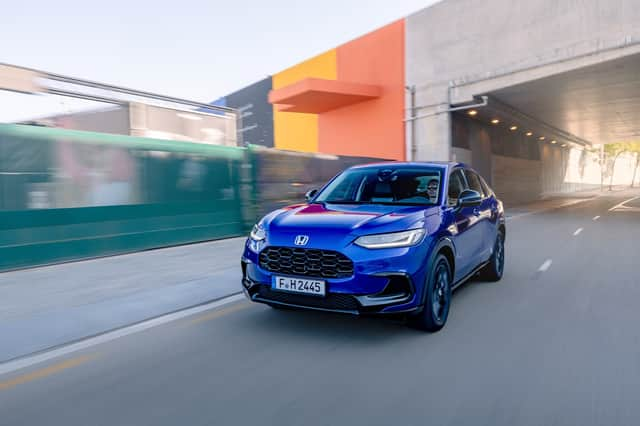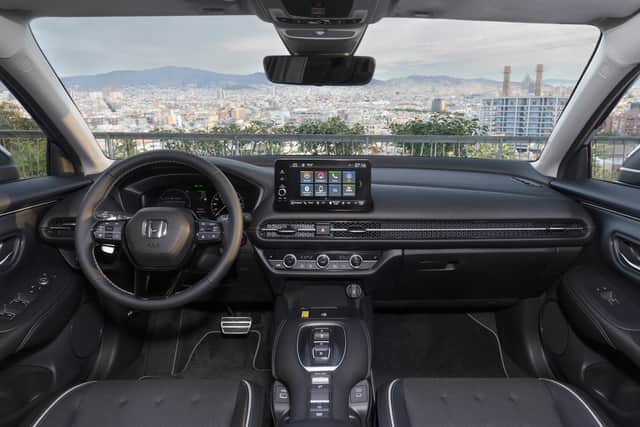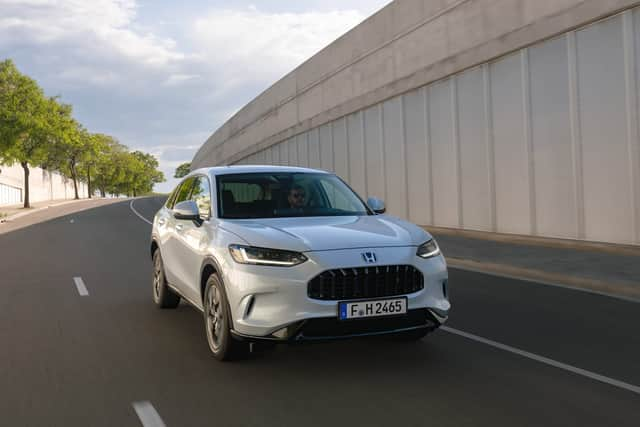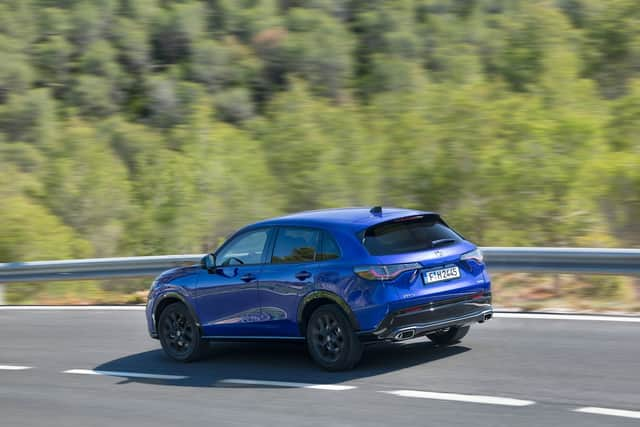Honda ZR-V review: UK price, specification and performance of new hybrid SUV rlval to the Nissan Qashqai


The family car market - nerdily referred to in the trade as the C segment - is massive business in the UK.
It’s estimated that by the end of 2023, C-segment models will represent 44% of new UK car sales and almost two thirds of them will be SUVs. In a field where once there was only the Nissan Qashqai, there are now more than 20 models fighting for families’ attention, with the likes of the Kia Sportage, Hyundai Tucson and Skoda Karoq doing their best to impress.
Advertisement
Hide AdAdvertisement
Hide AdHonda’s CR-V used to compete with such cars but the next generation, due later this year, has well and truly outgrown that segment, so in its place has emerged this - the ZR-V - to sit neatly below the enlarged CR-V and the compact HR-V.
Honda says it wants the ZR-V to offer the best bits of a saloon and an SUV. As if to emphasise that point the car is, indeed, part saloon and part SUV. The front section of the platform is borrowed from the Civic while the back end is lifted from the CR-V. The bit in the middle, though, that’s bespoke for the ZR-V.
As is the exterior which, to be truthful, is a little challenging. From the side and rear the smooth uncluttered lines are inoffensive and unremarkable. At the front, however, the ZR-V is, well, different. Its slimline headlights aren’t a problem - many manufacturers use a similar design well - the issue is the way they combine with the vertical slatted grille of Elegance and Advance models to make the car look like a cringing cartoon character.
Advance is the top specification but its weird face would almost be enough to persuade me to settle for the Sport trim, which gets a less offensive honeycomb grille as well as some side steps that give the car a more purposeful look, and some smart-looking matt black alloys.
Advertisement
Hide AdAdvertisement
Hide AdInside, it’s a far more pleasing affair. For many years Honda’s interiors lagged behind those of its European, Japanese and Korean competitors but the last influx of models - from the Jazz to the HR-V - have moved the game on significantly and, like those, the ZR-V is easily a match for most rivals.
There’s a lot of Civic about it, with the same broad honeycomb pattern decorating the simple dashboard facia and the same nine-inch infotainment screen sitting proud of the dash. There are also, joy of joys, proper dials for the dual-zone climate control and below then in high-spec models a handy wireless charging pad. Unlike the Civic’s broad centre console, the ZR-V’s curves in to reveal neat storage spaces and charging ports for mobile devices, ahead of another storage bin big enough for an iPad.


Switches and materials are also largely borrowed from the Civic, so everything has a well-built, soft-touch feel, while glass pearls in the door materials add an unusual glossy sheen to your surroundings. Fabric seats are standard on Elegance trim but Sports models get partial faux leather and Advance brings full perforated leather among its spec upgrades.
For a car that looks remarkably compact on the road, there’s a surprising amount of space in the ZR-V. Front and rear, the seating position and space are virtually identical to that of the Civic. That means truly adult-friendly levels of legroom and headroom but a knees-up seating position in the back that feels at odds with the raised ride height. Behind the rear seats, there’s 370 litres of luggage space, 20% more than the HR-V but a long way behind the 450-550 litres of the Qashqai, Sportage and Tucson.
Advertisement
Hide AdAdvertisement
Hide AdAt the other end, the ZR-V’s bonnet hides the latest version of Honda’s e:HEV hybrid powertrain. Shared with the Civic, this uses a 2.0-litre petrol engine, electric propulsion motor and integrated starter/generator to offer 181bhp, various drive modes and claimed economy of up to 48.7mpg.
Depending on the driving scenario, the car will shift between silent fully electric, fully petrol or hybrid driving modes almost undetectably. In hybrid mode the engine is disconnected from the wheels, acting as a generator for the electric propulsion motor in much the same way as the Qashqai’s e-Power system. However, it’s far quieter and smoother than the Nissan arrangement and only a very heavy throttle will prompt obvious engine noise, when both main motors work together to drive the wheels. Most of the time you’ll be hard pushed to identify which drive mode the car is in.
Honda’s claims that the ZR-V offers “exhilarating performance usually associated with sports hatchbacks” is a stretch even by the usual hyperbolic standards of new car announcements. This is, after all, a mid-sized family SUV and its performance and road manners are in keeping with that. Zero to 62mph takes a respectable 7.8 seconds and the steering is well weighted and direct, but even in sport mode everything feels composed rather than compelling. It corners ably enough and rides well on decent roads but doesn’t have the dynamism Honda would have you believe and poor surfaces expose an occasionally sharp low-speed ride.
In fairness to Honda, the segment is hardly awash with grin-inducing models, although something like a Mazda CX-5 will offer a little more in the way of driver engagement.
Advertisement
Hide AdAdvertisement
Hide AdOur first drive wasn’t enough to fairly gauge the ZR-V’s efficiency but the same system in the Civic is remarkably frugal and, allowing for the SUV’s less aerodynamic shape, I’d expect similar good things from the ZR-V, although nothing to make it stand clear of its rivals.
Low running costs are going to be important because the ZR-V isn't cheap to buy. While hybrid rivals start at around £34,000 and rise to £41,000, the entry level ZR-V Elegance starts at £39,495, Sport costs from £41,095 and Advance grade from £42,895.


Your £40k Elegance does come with the full Honda Sensing safety package, including adaptive cruise control, collision mitigation braking, auto-dipping headlights and driver awareness monitor, alongside a rear-view camera, all-round parking sensors, digital instruments, 18-inch alloys and the nine-inch touchscreen.
Sport adds the more attractive grille and steps, along with gloss black exterior trim, interior LED lighting, a power tailgate and wireless charging. On top of that, Advance gets a panoramic sunroof, head-up display, heated steering wheel and 12-speaker sound system, plus an enlarged instrument display and diamond-cut 18-inch alloys.
Advertisement
Hide AdAdvertisement
Hide AdIt's a modern and generous spec but it's nothing that rivals can't match, generally for a couple of thousand pounds less, and, aside from its impressive drivetrain, the ZR-V does little to stand out from the crowd.
Like so many in the segment it's a decent but largely unremarkable family SUV. It looks and feels like an SUV version of the Civic, offering the same competent and undemanding ownership prospect. Which raises the question of why would you spend an extra £8,000 to have it over the Civic.


Honda ZR-V Sport
- Price: £41,095
- Engine: 2.0-litre, four-cylinder petrol/electric full hybrid
- Power: 181bhp
- Torque: 232lb ft
- Transmission: E-CVT
- Top speed: 107mph
- 0-62mph: 7.8 seconds
- Economy: 48.7mpg
- CO2 emissions: 132g/km
Rivals: Ford Kuga, Hyundai Tucson, Kia Sportage, Nissan Qashqai, Peugeot 3008, Renault Austral, Skoda Karoq, Volkswagen Tiguan
Comment Guidelines
National World encourages reader discussion on our stories. User feedback, insights and back-and-forth exchanges add a rich layer of context to reporting. Please review our Community Guidelines before commenting.
